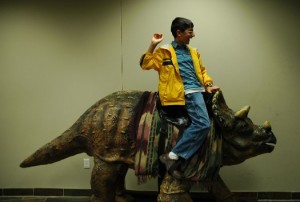 Recently The Chronicle of Higher Education reported that under 30% of Americans are science literate. You read that right – over 70% of us are science illiterate. Half of the country thinks that humans were rubbing elbows with dinosaurs. In “Teaching Science So It Sticks,” Dan Berrett describes some of the efforts universities are making to increase science literacy among non-STEM majors to produce more knowledgeable citizens.
If you’ve ever dropped into this blog before, then the teaching methods being applied will sound familiar. The University of Oregon has changed up the names of introductory science courses, for example, “Introduction to Geology” has become “People, Rocks, & Fire.” The faculty use group-work assignments and “flipped” classrooms. Bard College offers a winter intersession course in which the students do research in a citizen science project.
Basically, faculty are making the science content more relevant and engaging for the students – that is what makes the science stick. This is exactly the kind of teaching STEM majors request when they are surveyed or interviewed about the difficulties of completing a science major. Even though they are talented in science, they still need the social context and applications of science to stay motivated in their studies and eventual careers. STEM retention initiatives focusing on pedagogy could learn a lot from these “lowly” science literacy initiatives.
Image: Attributed to John Scalzi, “The Image You’ve Slogged through the Whole Set to See,” 2007. Some rights reserved.
Recently The Chronicle of Higher Education reported that under 30% of Americans are science literate. You read that right – over 70% of us are science illiterate. Half of the country thinks that humans were rubbing elbows with dinosaurs. In “Teaching Science So It Sticks,” Dan Berrett describes some of the efforts universities are making to increase science literacy among non-STEM majors to produce more knowledgeable citizens.
If you’ve ever dropped into this blog before, then the teaching methods being applied will sound familiar. The University of Oregon has changed up the names of introductory science courses, for example, “Introduction to Geology” has become “People, Rocks, & Fire.” The faculty use group-work assignments and “flipped” classrooms. Bard College offers a winter intersession course in which the students do research in a citizen science project.
Basically, faculty are making the science content more relevant and engaging for the students – that is what makes the science stick. This is exactly the kind of teaching STEM majors request when they are surveyed or interviewed about the difficulties of completing a science major. Even though they are talented in science, they still need the social context and applications of science to stay motivated in their studies and eventual careers. STEM retention initiatives focusing on pedagogy could learn a lot from these “lowly” science literacy initiatives.
Image: Attributed to John Scalzi, “The Image You’ve Slogged through the Whole Set to See,” 2007. Some rights reserved.
Lessons from Science Literacy
 Recently The Chronicle of Higher Education reported that under 30% of Americans are science literate. You read that right – over 70% of us are science illiterate. Half of the country thinks that humans were rubbing elbows with dinosaurs. In “Teaching Science So It Sticks,” Dan Berrett describes some of the efforts universities are making to increase science literacy among non-STEM majors to produce more knowledgeable citizens.
If you’ve ever dropped into this blog before, then the teaching methods being applied will sound familiar. The University of Oregon has changed up the names of introductory science courses, for example, “Introduction to Geology” has become “People, Rocks, & Fire.” The faculty use group-work assignments and “flipped” classrooms. Bard College offers a winter intersession course in which the students do research in a citizen science project.
Basically, faculty are making the science content more relevant and engaging for the students – that is what makes the science stick. This is exactly the kind of teaching STEM majors request when they are surveyed or interviewed about the difficulties of completing a science major. Even though they are talented in science, they still need the social context and applications of science to stay motivated in their studies and eventual careers. STEM retention initiatives focusing on pedagogy could learn a lot from these “lowly” science literacy initiatives.
Image: Attributed to John Scalzi, “The Image You’ve Slogged through the Whole Set to See,” 2007. Some rights reserved.
Recently The Chronicle of Higher Education reported that under 30% of Americans are science literate. You read that right – over 70% of us are science illiterate. Half of the country thinks that humans were rubbing elbows with dinosaurs. In “Teaching Science So It Sticks,” Dan Berrett describes some of the efforts universities are making to increase science literacy among non-STEM majors to produce more knowledgeable citizens.
If you’ve ever dropped into this blog before, then the teaching methods being applied will sound familiar. The University of Oregon has changed up the names of introductory science courses, for example, “Introduction to Geology” has become “People, Rocks, & Fire.” The faculty use group-work assignments and “flipped” classrooms. Bard College offers a winter intersession course in which the students do research in a citizen science project.
Basically, faculty are making the science content more relevant and engaging for the students – that is what makes the science stick. This is exactly the kind of teaching STEM majors request when they are surveyed or interviewed about the difficulties of completing a science major. Even though they are talented in science, they still need the social context and applications of science to stay motivated in their studies and eventual careers. STEM retention initiatives focusing on pedagogy could learn a lot from these “lowly” science literacy initiatives.
Image: Attributed to John Scalzi, “The Image You’ve Slogged through the Whole Set to See,” 2007. Some rights reserved.



Leave a Reply